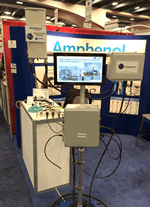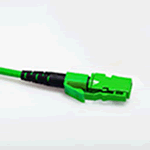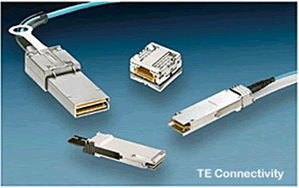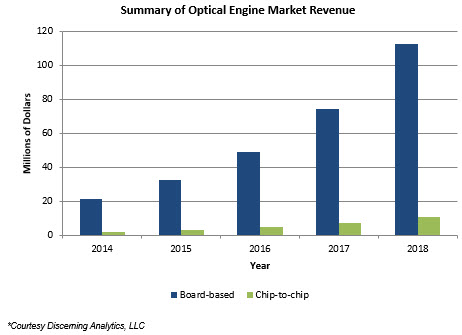Leading Connector Suppliers Showcased at OFC 2014
Many top connector companies have re-entered the active optical communications industry, mainly due to the obvious bandwidth and size limitations of their copper products. Here’s a look at the technology leading connector suppliers showcased at OFC 2014.
 Amphenol, Corning, FCI, Hirose, Molex, Samtec, TE Connectivity, and US Conec showcased their products at the Optical Fiber Communications (OFC) Conference that was held March 9-13 in San Francisco, Calif. The keynote speakers included all facets of the optical communications value chain, with representatives from MIT Computer Science Research Lab, Ciena, Alcatel-Lucent Bell Labs, and Windstream. Bishop & Associates’ Lisa Huff reports on the latest and greatest technology on display at the show.
Amphenol, Corning, FCI, Hirose, Molex, Samtec, TE Connectivity, and US Conec showcased their products at the Optical Fiber Communications (OFC) Conference that was held March 9-13 in San Francisco, Calif. The keynote speakers included all facets of the optical communications value chain, with representatives from MIT Computer Science Research Lab, Ciena, Alcatel-Lucent Bell Labs, and Windstream. Bishop & Associates’ Lisa Huff reports on the latest and greatest technology on display at the show.
The relationship between the top connector manufacturers and the active optical communications industry has been a tenuous one at best – with most exiting then re-entering the market. But they seem to be in it to stay now, mainly due to the obvious bandwidth and size limitations of their copper products.
The OFC Conference
The Optical Fiber Communications Conference (OFC) is the world’s largest optical communications technology conference in the world. This year it saw almost 13,000 attendees, with 800 presentations and 550 exhibitors. Technical and market-driven papers were discussed. The technical series included short courses, workshops, tutorials, and technical sessions. The more market-driven material was viewed at the executive forum or on the show floor.
OFC Exhibit Floor
Four of Bishop & Associates‘ top 10 connector companies (by worldwide sales) showed products on the exhibition floor. Highlights of the top three, plus Corning, which is the top optical cable supplier in the industry, are detailed below.
Amphenol (#2)
 Amphenol had its own booth and also took part in the Ethernet Alliance (EA) demonstration. The EA live demo showed multiple data centers interconnected, via 100-Gigabit Ethernet connections across routers from three different equipment manufacturers. Numerous configurations of switches, servers, and test equipment were used within each “data center.” The equipment was connected with a combination of 10G, 40G, and 100G Ethernet and highlighted some of the breakout cables that make it possible to intermix 10G and 40G in networks today. It also included all the 100G form factors – QSFP28, CFP, CFP2, CPAK, and CFP4. Just like last year, Amphenol provided connectors, direct-attach copper (DAC), and active optical cables (AOCs) for this demo.
Amphenol had its own booth and also took part in the Ethernet Alliance (EA) demonstration. The EA live demo showed multiple data centers interconnected, via 100-Gigabit Ethernet connections across routers from three different equipment manufacturers. Numerous configurations of switches, servers, and test equipment were used within each “data center.” The equipment was connected with a combination of 10G, 40G, and 100G Ethernet and highlighted some of the breakout cables that make it possible to intermix 10G and 40G in networks today. It also included all the 100G form factors – QSFP28, CFP, CFP2, CPAK, and CFP4. Just like last year, Amphenol provided connectors, direct-attach copper (DAC), and active optical cables (AOCs) for this demo.
In its own booth, Amphenol Fiber Optic Products Division highlighted its products used in wireless backhaul systems, including both RF and optical.
Corning (#65)

Figure 3: Corning MXC Cable Assembly (Source: Corning)
While Corning is ranked outside the top 50 connector manufacturers list, it is number one in the fiber-optic connectivity market by leveraging its number-one position in the fiber business. Corning supplies pre-terminated assemblies for use in data centers and LAN and has the top-selling fiber cable management system in its Pretium EDGE solutions.
This year, Corning introduced its MXC connectivity solution that it co-developed with Intel to support the chip giant’s silicon photonics program. While US Conec designed the connector, Corning developed a new multi-mode 1310nm fiber to go with it. The solution promises higher-density 25Gb/s-per-lane operation over up to 4km using this new fiber.
Molex (#3)

Figure 4: Molex MXC, MPO FlexiBend boot, Expanded-Beam Ruggedized and iPass Cable Assemblies (Source: Molex)
Molex showcased several new products at OFC (pictured at the right). The MXC assemblies are a second source to Corning and are used with Intel’s silicon photonics solution for disaggregated racks in the data center; they can also be used with traditional VCSEL arrays. FlexiBend MPO flexible-boot cable assemblies assist with cable management for tight high-density racks in data centers. The Expanded-Beam Ruggedized Optical cable assembly is for severe environments with applications in aerospace and defense. The iPass+ HD AOC is used in SAS-3.0 systems.
In addition, supporting the OIF, Molex presented a demonstration of the new CDFP 400G solutions, which are based on 25Gb/s lanes.
TE Connectivity (#1)

Figure 5: TE Connectivity’s Coolbit Products (Source: TE Connectivity)
TE Connectivity had its own booth and also supported the EA demonstration with its cable assemblies and transceiver modules. It displayed a new thermal adhesive-coated (TAC) fiber that can be used for indoor fiber installations. Once the TAC fiber is installed, it is nearly invisible. Another product shown was its power-over-Ethernet fiber replacement. The most interesting new technology included in the exhibit, however, was its Coolbit optical engines. TE expects to initially release four products utilizing this technology – 100G QSFP28 AOCs and transceivers, 300G mid-board optical modules, and 400G CDFP AOCs.
Optical Engines for Data Center Applications
Because optical engines seem to progress each year at OFC, it has become a tradition to include a market forecast for them in this OFC review article. The optical engine market growth will be fueled by more than the traditional III-V semiconductor materials, like InP and GaAs, as evidenced by Molex’s, Cisco’s, Mellanox’s, and Ranovous’ silicon photonics products that were displayed at the conference. FCI and Samtec are also developing optical engines using traditional high-speed components.
Optical engines have been around for many years, and are increasingly being utilized in applications in chip-to-chip, board-to-board, and optical backplanes, in addition to their common use as building blocks for optical transceivers such as the SFP+, QSFP+, QSFP28, CFP, CFP2, CFP4, and CPAK modules. One of the growing technological advances pushing optical engines into the foreground is the disaggregated rack in the data center. If this takes off, the market for optical engines could easily ramp up more quickly than we show here.
The chart* below shows the small but growing market for optical engine products.
By no means will optical-engine-based interconnects take over the network in the near term. Copper ones are still quite viable for short-reach 100G systems and below. But with density being an issue and the advent of disaggregated racks being pushed by more than one end user (Facebook, Google, Microsoft), they will become an increasing threat to copper-based systems. The challenge for the connectivity vendors to take part in this market will be to keep up with their transceiver and systems manufacturers’ customers, who will be competing with similar products in the same space.
Lisa Huff, Market Director, Bishop & Associates, Inc.






